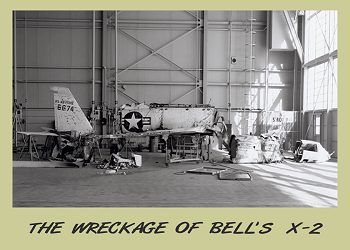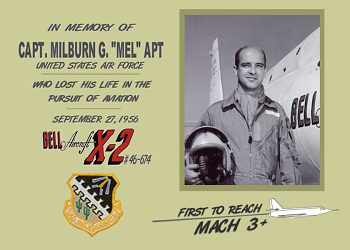
 |
Apt was known for remaining cool under stressful situations. While flying chase for a Lockheed F-94C on a test sortie, there was an emergency. The test aircraft crash landed on the dry lakebed at Edwards and Richard J. Harer was trapped in the cockpit. Apt landed along side the stricken craft and rushed to Harer's aid. At great personal risk, Apt pulled Harer from the burning plane and saved his life.
Apt accepted an assignment as an experimental test pilot at the Air Force Flight Test Center at Edwards in April 1955. He served as a flight test engineer and project pilot on various aircraft test programs and conducted inertial coupling tests in the F-100. Apt was assigned to the X-2 program in February 1956 and flew several chase missions in support of Iven Kincheloe's X-2 flights.
Finally, in September 1956, he was offered the opportunity to fly the X-2 himself. After several ground briefings in the simulator, Apt (with no previous rocket plane experience) was scheduled to make his first flight on 27 September. Just before the flight Kincheloe, who would perform chase duties, expressed his confidence in Apt's abilities. "You've got it hacked, dad," he told Apt.
After being lofted to altitude and released Apt raced away from the B-50 under full power, quickly outdistancing the F-100 chase planes. At high altitude, he nosed over, accelerating rapidly. The X-2 reached Mach 3.2 (2,094 mph) at 65,500 feet. Apt became the first man to fly more than three times the speed of sound.
Still above Mach 3, he began an abrupt turn back to Edwards. The maneuver proved fatal as the X-2 began a series of diverging rolls and tumbled out of control. Apt was briefly knocked unconscious, but came to and tried to regain control of the aircraft. Unable to do so, Apt separated the escape capsule and was again knocked unconscious as it pitched down. Too late, he attempted to bail out and was killed when the capsule impacted on the Edwards bombing range. The remainder of the X-2 crashed five miles away.
 |
